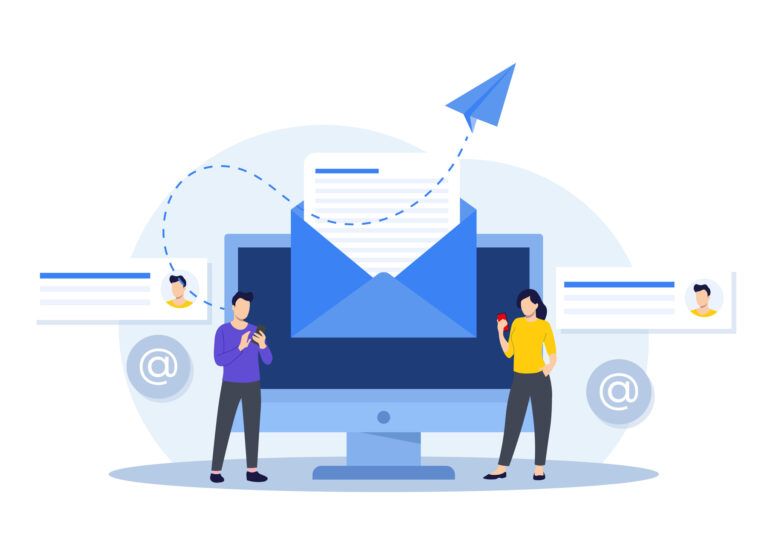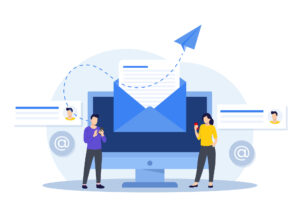Why aren’t people opening your emails? You put in the work, craft the perfect message, and hit send, only to see low open rates and little engagement. With inboxes overflowing and attention spans shrinking, getting your emails noticed is harder than ever.
But there’s good news. There are proven ways to boost open rates and get your emails in front of the right audience. In this guide, we’ll cover practical, beginner-friendly tactics to help you craft compelling subject lines, optimize send times, and personalize your emails for better engagement.
#1. Strong Subject Lines: The Key to Getting Noticed
Your subject line is the first (and sometimes only) chance to grab your reader’s attention. If it doesn’t stand out in a crowded inbox, your email will be ignored – or worse, sent straight to the trash.
So, what makes a great subject line? It’s short, personal, and sparks curiosity or urgency. The best ones feel relevant, offer clear value, and make the reader want to click.
Here’s how to write subject lines that get opened:
- Keep It Short and Clear: Aim for 6–10 words to make sure it’s fully visible, especially on mobile devices.
- Use Personalization: Including the recipient’s name, location, or past interactions makes the email feel tailored.
- Create a Sense of Urgency: Phrases like “Ends Tonight” or “Only a Few Spots Left” encourage immediate action.
- Spark Curiosity: A well-placed question or teaser makes people want to learn more.
Check out these examples:
- “John, your exclusive offer expires at midnight!” (Personalization + Urgency)
- “We need to talk about your cart…” (Curiosity + Reminder)
- “Limited spots left – are you in?” (Scarcity + Urgency)
The key here is that subject lines are the gateway to your emails. Make them engaging, relevant, and irresistible to increase your open rates.
#2. Segmentation: Sending the Right Message to the Right People
Sending the same email to your entire list is like shouting into a crowd and hoping the right person hears you. The more relevant your email is, the higher the chances it will be opened. That’s where email segmentation comes in.
Segmentation means dividing your email list into smaller, targeted groups based on behavior, interests, demographics, or where they are in the buying journey. Instead of sending one-size-fits-all emails, you send content that speaks directly to what a specific group cares about.
Below are a few ways to segment your email list:
- By Behavior: Target subscribers based on what they’ve done (or haven’t done). Example: Send a reminder email to people who abandoned their cart.
- By Interests: If someone signed up for web design tips, don’t send them email marketing content. Give them what they asked for.
- By Location: If you’re running a local event, only email people in that area to avoid sending irrelevant messages.
- By Engagement Level: Treat active subscribers differently from those who haven’t opened an email in months.
Why Segmentation Increases Open Rates:
- More relevance = higher engagement. People open emails that feel tailored to them.
- Less unsubscribes because subscribers receive only what matters to them.
- Higher conversions since the right audience gets the right offer at the right time.
If you’re struggling with low open rates, start segmenting. Even small tweaks, like sending different emails to engaged vs. inactive subscribers, can make a huge difference in how your audience responds.
#3. Optimal Send Times: Timing Can Make or Break Your Open Rates
You can have the perfect subject line and a well-targeted audience, but if your email lands in their inbox at the wrong time, it won’t get opened. Timing plays a huge role in email success, and finding the best time to send is key to increasing open rates.
Here are a few ways to find the right timing:
- Test Different Times: Every audience is different. Try sending emails on different days and at different times to see what works best.
- Consider Mid-Week Mornings or Afternoons: Studies show that Tuesday, Wednesday, and Thursday mornings (8–11 AM) or afternoons (1–3 PM) tend to perform well.
- Think About Your Audience’s Routine: A B2B email might work best before work or during lunch breaks, while a B2C email could perform better in the evening or on weekends.
- Use AI and Automation Tools: Email platforms with AI-driven send-time optimization analyze subscriber behavior and deliver emails at the moment they’re most likely to be opened.
Example: A clothing retailer might find that sending promotional emails at 7 PM on Fridays leads to more opens, while a B2B company may have better results sending newsletters at 10 AM on Wednesdays.
In other words, the best send time isn’t a one-size-fits-all rule. It’s something you test, refine, and optimize based on your audience’s habits.
#4. Technical Optimization: Ensuring Your Emails Actually Reach the Inbox
Low open rates don’t always mean people aren’t interested. Sometimes, your emails aren’t even getting delivered. Ensuring proper email authentication and list hygiene helps improve deliverability and prevents your emails from getting flagged as spam.
Here’s what to do:
- Set Up DMARC, DKIM, and SPF: These email authentication protocols verify that your emails are legitimate, helping prevent spoofing and phishing attacks.
- Monitor Your Sender Reputation: Email service providers track how recipients interact with your emails. High bounce rates, spam complaints, and low engagement can hurt your reputation and reduce deliverability.
- Regularly Clean Your Email List: Remove inactive subscribers and invalid addresses to keep your list fresh and improve email performance.
- Avoid Spam Triggers: Certain words and excessive punctuation (FREE!!!, $$$, URGENT!) can send your email straight to the spam folder.
Pro Tip: If you notice a drop in open rates, check your bounce rate and spam reports. If your emails aren’t reaching inboxes, authentication issues or a poor sender reputation could be the problem.
#5. Mobile Optimization: If It Doesn’t Look Good on a Phone, It Won’t Get Read
Over 50% of emails are opened on mobile devices, and that number keeps growing. If your email isn’t mobile-friendly, readers will delete it within seconds. Optimizing for mobile isn’t an extra step – it’s a necessity.
Here are a few tips on how to make emails mobile-friendly:
- Use a Responsive Design: Your emails should automatically adjust to different screen sizes for a seamless experience.
- Keep Subject Lines Short: Mobile inboxes cut off long subject lines. Stick to 6–10 words to ensure your message is clear.
- Make CTAs Big and Clickable: Small links are hard to tap on a phone. Use large, easy-to-click buttons for your call-to-action.
- Use Simple, Scannable Content: People skim on mobile. Break up text into short paragraphs, use bullet points, and avoid large blocks of text.
Ultimately, what to know here is that a newsletter with tiny fonts, small images, and long paragraphs might work on a desktop but will look messy on a phone. A responsive, well-structured email ensures a smooth reading experience on any device.
#6. Personalized Content: Make Every Email Feel Tailored
People ignore generic emails but open messages that feel personal and relevant. However, personalization goes beyond adding a first name. It’s about using real-time data to craft emails that resonate with each subscriber.
Here are a few ways to personalize emails for higher open rates:
- Use Purchase History: Recommend products based on what a customer has already bought. Example: “You might love these accessories for your new camera!”
- Consider Location & Timing: Send weather-based promotions (“Stay warm this winter – shop our best-selling coats!”) or reminders for local events.
- Customize Based on Engagement: Reward loyal subscribers with exclusive offers and re-engage inactive ones with special incentives.
- Leverage Dynamic Content: Show different email content based on user preferences or behaviors.
When emails feel relevant, people are more likely to open, engage, and convert. The more tailored your messaging, the better your open rates will be.
Bonus Tip: Build Trust with Data Transparency
People are becoming more cautious about how their data is used. If they don’t trust you, they won’t engage.
- Comply with GDPR/CCPA: Always get clear consent before collecting data and provide an easy opt-out option.
- Be Transparent About Data Usage: Let subscribers know why you collect data and how it improves their experience.
- Make Unsubscribing Hassle-Free: Nothing destroys trust faster than a difficult opt-out process.
Start Implementing These Strategies Today
If you’re struggling with low open rates, that ends today. With the right subject lines, smart segmentation, and optimized timing, your emails can stand out in crowded inboxes. So, now’s the time to take action. Test different approaches, refine your strategy, and watch your open rates grow. The more relevant and engaging your emails are, the better results you’ll see in your marketing efforts.
Ready to make every email count? Start with NovaExpress.ai to craft personalized, high-impact emails that skyrocket open rates and drive conversions!
Frequently Asked Questions
What is a good email open rate in 2025?
In 2025, a good email open rate typically ranges between 20% and 30% across most industries. Top-performing sectors like education, nonprofits, and retail often achieve 40–50%.
Based on Mailchimp’s 2025 benchmarks, the average open rate is 26.8%, but it varies by niche. Always compare your results to industry standards — audience quality, list hygiene, and content relevance play a major role.
How do I write a subject line that gets opened?
An effective subject line should be:
- Short: 6–10 words
- Personalized: “Anna, your exclusive offer ends tonight!”
- Curious or urgent: “You left this in your cart…”
- Spam-free: Avoid “FREE!!!” or excessive punctuation
Research shows personalized subject lines increase open rates by 26% (Experian) — making them a must-use tactic.
What is the best time to send marketing emails?
The best time is usually 9:00–11:00 AM on Tuesdays, Wednesdays, or Thursdays.
For B2C brands, evenings (6–8 PM) on Fridays or weekends can also perform well.
According to a Nova Express study, Tuesdays at 10 AM have the highest average open rates. But the ideal timing depends on your audience — use A/B testing or AI-powered send-time optimization to deliver emails when each subscriber is most likely to engage.









Leave a Comment